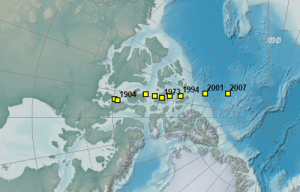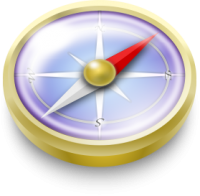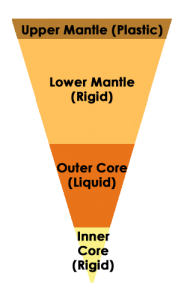 The Story of the Explorer’s Compass
The Story of the Explorer’s Compass
Imagine. You are an explorer standing exactly on the North Pole.
It’s been a long journey and it’s freezing cold.
You pull out your compass.
What direction would the needle on the compass point?
The answer may not be what you think.
In order to answer this question, you will have to understand the difference between the true geographic north and magnetic north.
Because these two north locations are completely different.
What is the Geographic (True) North Pole?

The Earth rotates on the geographic north and south poles. The geographic north and south poles are where lines of longitude (meridians) converge in the north. The south and north pole are directly opposite to one another.
The North Pole is located in the middle of the Arctic Ocean. Scientists have tried marking the North pole. Because the water here is permanently covered with moving sea ice, it’s practically impossible to construct any type of permanent station at the true North Pole.
On the other side of the Earth, the South Pole lies on a continental land mass known as Antarctica. Because the ice on top of Antarctica moves only a few meters a year, the United States Antarctica program has installed a marker here to delineate the true South Pole.
What is the Magnetic North Pole?
The Earth is one big magnet.
The Magnetic North Pole (also known as the North Dip Pole) is a point on Ellesmere Island in Northern Canada where the northern lines of attraction enter the Earth.
A compass needle rests freely in its casing so it can maneuver itself. When you pull out a compass, it aligns itself with the Earth’s magnetic field. The small magnetic pin is how a compass responds to Earth’s magnetism.
This means that a compass needle will point to the Magnetic North Pole – which is different from the geographic north.
But how much of a difference is the magnetic north vs geographic north?

Where are the Magnetic North Pole and Geographic North Pole?

The question is:
Where would a compass needle point if you were standing on the true North Pole?
If you were standing on the geographic north pole holding your compass, it would point towards northern Canada at Ellesmere Island. This is a difference of about 500 kilometers between the Geographic North and Magnetic North poles!
This difference is called the magnetic inclination. Magnetic deviation is the error of a compass needle including nearby metallic objects.
Magnetic inclination varies according to where you are located on the globe. In order to point you in the right directions, users can compensate for magnetic inclination by using charts of declination or local calibration.
The difference today is about 500 kilometers. But the Magnetic North Pole is actually moving kilometers every year. This phenomenon is known as the Polar Shift Theory.
Polar Shift Theory: Earth’s Ever-Changing Magnetic North Pole

The world we live on is dynamic. Earth is changing every day.
Plate tectonics push continents apart, sea levels fluctuate up and down, volcanoes erupt discharging ash and smoke…
These are examples of natural phenomena that occur in cycles and are dynamic on our planet. The location of our magnetic north is really no different.
Over the last 150 years, the magnetic pole has crept north over 1000 kilometers. Scientists suggest it migrates about 10 kilometers per year and can even flip from pole-to-pole. Lately, the speed has accelerated to about 40 kilometers per year and could reach Siberia in a few decades.
NOAA’s historical declination map shows lines of constant magnetic declination (isogonic lines). Isogonic lines are an indication for what direction compass needles will point – along the lines of magnetic force.
Polar Reversals: South-Pole Pointing Compass
Imagine your compass pointing south instead of north.

If you were alive to see it 800,000 years ago, it would have been the Magnetic South Pole.
It takes 200,000 to 300,000 years for Earth’s magnetic field to flip polarity. Flipping polarity means the lines of attraction that enter the Earth would flip north to south pole, or vice versa.
This means that it has been twice that long since the last reversal. Some believe we are long overdue for a pole reversal.
But there’s really no need to panic:
NASA scientists say a reversal happens over hundreds or thousands of years. It’s not exactly a clean back flip that happens like a flick of a switch.
Why Does the Earth Have a Magnetic Field in the First Place?

Geophysicists believe Earth’s magnetic fields presence is because of what the Earth is made up of.
The Earth consists of a solid iron core. Surrounding the iron core is an ocean of hot, liquid metal. The liquid metal that flows in Earth’s core creates electrical currents, which in turn creates our magnetic field.
Unlike a solid fridge magnet, the liquid metal surrounding the inner core moves freely. This explains why the magnetic pole can migrate.
Although geophysicists cannot measure the inner core directly, this is why there is a strong belief that the matter governing Earth’s magnetic field moves around.
Magnets, Compasses and North Bearings
The Geographic North Pole differs from the Magnetic North Pole by about 500 kilometers.
The Geographic North Pole is where lines of longitudes converge into what we call the North Pole. The Magnetic Pole is a point in Northern Canada where the northern lines of attraction enter the Earth.
A compass needle will point to the direction of the Magnetic North Pole. But this doesn’t mean that a compass always points to the Geographic North Pole. This difference is magnetic inclination.
The Earth’s magnetic north is changing every day because of the hot, liquid metal that surrounds the inner core. It can change so much that the Earth’s magnetic field can flip polarity. This is called the Polar Reversal Theory.
Next time you’re out in the woods with your compass, don’t forget about the small magnetic pin that moves freely in the direction of the Magnetic North Pole.

No comments:
Post a Comment
Thanks for your comments